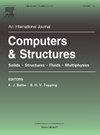考虑规则和不规则特征的生物结构的广义重构和生长机制:计算研究
IF 4.8
2区 工程技术
Q1 COMPUTER SCIENCE, INTERDISCIPLINARY APPLICATIONS
引用次数: 0
摘要
许多软体生物结构具有粘弹性和超弹性材料的天然特性。从理论和实验的角度来看,研究这些结构的生长生物力学是具有挑战性的,特别是当考虑到生物物体的不规则形状/缺陷时。为此,本文努力为生物软结构(如动脉、皮肤或不同组织)的生长建立一个通用的非线性有限元模型。考虑粘弹性分支的非牛顿流体。首次考虑了厚度变化、几何形状不规则以及生物结构缺陷等因素的影响。得到了各向同性和各向异性材料性能的一般非线性公式。此外,采用两种有效的隐式梯形时间积分格式求解生长和粘弹性分支的内变量演化方程。为了研究所提出模型的适用性,将所得结果与文献中关于皮肤生长的临床研究结果进行比较。结果表明,该模型能够很好地捕获实验观测值。此外,所提出的模型能够研究不同形状的生物结构,以及厚度增长的变化,包括规则和不规则的缺陷,这是以前从未研究过的。本文章由计算机程序翻译,如有差异,请以英文原文为准。
Generalized reconfigurations and growth mechanics of biological structures considering regular and irregular features: A computational study
Many soft biological structures have natural features of viscoelastic and hyperelastic materials. Research focused on the growth biomechanics of these structures is challenging from theoretical and experimental points of view, especially when irregular forms/defects of biological objects should be considered. To this aim, an effort is made in this paper to develop a general nonlinear finite element model for the growth of biological soft structures such as arteries, skin or different tissues. The non-Newtonian fluid is considered for viscoelastic branches. The effect of variation in thickness growth and irregular geometry as well as defects of biostructure is taken into account for the first time. The general nonlinear formulations are obtained for isotropic as well as anisotropic material properties. Furthermore, to resolve evolution equations resulting of internal variables for growth as well as viscoelastic branches, two effective implicit trapezoidal time integration schemes are employed. To study the applicability of the proposed model, the obtained results are compared with results from clinical studies for skin growth, available in the literature. The results demonstrate that the present model enables to capture of the experimental observations with very good accuracy. Additionally, the presented model enables to study of different shapes of biostructure, and variation in thickness growth, including regular and irregular defects, which have never been investigated previously.
求助全文
通过发布文献求助,成功后即可免费获取论文全文。
去求助
来源期刊

Computers & Structures
工程技术-工程:土木
CiteScore
8.80
自引率
6.40%
发文量
122
审稿时长
33 days
期刊介绍:
Computers & Structures publishes advances in the development and use of computational methods for the solution of problems in engineering and the sciences. The range of appropriate contributions is wide, and includes papers on establishing appropriate mathematical models and their numerical solution in all areas of mechanics. The journal also includes articles that present a substantial review of a field in the topics of the journal.
 求助内容:
求助内容: 应助结果提醒方式:
应助结果提醒方式:


